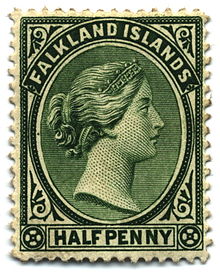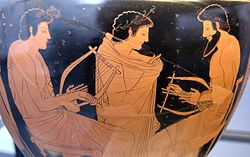Collecting
Stamp collecting is generally accepted as one of the areas that make up the wider subject of
philately, which is the study of stamps. A philatelist may, but does not have to, collect stamps. It is not uncommon for the term
philatelist to be used to mean a stamp collector. Many casual stamp collectors accumulate stamps for sheer enjoyment and relaxation without worrying about the tiny details. The creation of a large or comprehensive collection, however, generally requires some philatelic knowledge and will usually contain areas of philatelic studies.
Postage stamps are often collected for their historical value and geographical aspects and also for the many subjects depicted on them, ranging from ships, horses, and birds to kings, queens and presidents.
Stamp collectors are an important source of income for some countries who create limited runs of elaborate stamps designed mainly to be bought by stamp collectors. The stamps produced by these countries may exceed their postal needs, but may also feature attractive topical designs that many collectors desire.

Queen Victoria's profile was a staple on 19th century stamps of the
British Empire; here on a half-penny of the Falkland Islands, 1891.
History
It has been suggested that John Bourke, Receiver General of Stamp Dues in
Ireland, was the first collector. In 1774 he assembled a book of the existing embossed
revenue stamps, ranging in value from 6 pounds to half a penny, as well as the hand stamped charge marks that were used with them. His collection is preserved in the
Royal Irish Academy,
Dublin.
Postage stamp collecting began at the same time that stamps were first issued, and by 1860 thousands of collectors and stamp dealers were appearing around the world as this new study and hobby spread across
Europe, European colonies, the
United States and other parts of the world.
The first postage stamp, the
Penny Black, was issued by
Britain in May 1840 and pictured a young
Queen Victoria. It was produced without
perforations (imperforate) and consequently had to be cut from the sheet with scissors in order to be used. While unused examples of the Penny Black are quite scarce, used examples are quite common, and may be purchased for $20 to $200, depending upon condition.
People started to collect stamps almost immediately. One of the earliest and most notable was
John Edward Gray. In 1862, Gray stated that he "began to collect postage stamps shortly after the system was established and before it had become a rage".
Women stamp collectors date from the earliest days of postage stamp collecting. One of the earliest was
Adelaide Lucy Fentonwho wrote articles in the 1860s for the journal
The Philatelist under the name Herbert Camoens.
As the hobby and study of stamps began to grow, stamp albums and stamp related literature began to surface, and by the early 1880s publishers like
Stanley Gibbonsmade a business out of this advent.
Children and teenagers were early collectors of stamps in the 1860s and 1870s. Many adults dismissed it as a childish pursuit but later many of those same collectors, as adults, began to systematically study the available postage stamps and publish books about them. Some stamps, such as the triangular issues of the
Cape of Good Hope, have become legendary.
Stamp collecting is a less popular
hobby in the early 21st century than it was a hundred years ago. In 2013, the Wall Street Journal estimated the global number of stamp collectors was around 60 million.Tens of thousands of stamp dealers supply them with stamps along with stamp albums, catalogues and other publications. There are also thousands of stamp (philatelic) clubs and organizations that provide them with the history and other aspects of stamps. Today, though the number of collectors is somewhat less, stamp collecting is still one of the world's most popular indoor hobbies.
Equipment
A few basic items of equipment are recommended for proper stamp collection. Stamp tongs help to handle stamps safely, a magnifying glass helps in viewing fine details and an album is a convenient way to store stamps. The stamps need to be attached to the pages of the album in some way, and stamp hinges are a cheap and simple way to do this. However, hinging stamps can damage them, thus reducing their value; today many collectors prefer more expensive hingeless mounts. Issued in various sizes, these are clear, chemically neutral thin plastic holders that open to receive stamps and are gummed on the back so that they stick to album pages. Another alternative is a stockbook, where the stamps drop into clear pockets without the need for a mount. Stamps should be stored away from light, heat and moisture or they will be damaged.
Stamps can be displayed according to the collector's wishes, by country, topic, or even by size, which can create a display pleasing to the eye. There are no rules and it is entirely a matter for the individual collector to decide. Albums can be commercially purchased, downloaded or created by the collector. In the latter cases, using acid free paper provides better long-term stamp protection.
A
stockbook with clear plastic pockets is one of the safest ways to store stamps. Some collectors prefer a traditional stamp album.
Clockwise from top left: hinge-mounted stamp, stamp about to be hinge-mounted, stamp damaged by a hinge,
stamp hinges.
-
Stamp tongs with rounded tips help to prevent damage to stamps from skin oils and rough handling
Acquiring stamps
Many collectors ask their family and friends to save stamps for them from their mail. Although the stamps received by major businesses and those kept by elderly relatives may be of international and historical interest, the stamps received from family members are often of the definitive sort. Definitives seem mundane but, considering their variety of colours, watermarks, paper differences, perforations and printing errors, they can fill many pages in a collection. Introducing either variety or specific focus to a collection can require the purchasing of stamps, either from a dealer or online. Online stamp collector clubs often contain a platform for buying/selling and trading. Large numbers of relatively recent stamps, often still attached to fragments or envelopes, may be obtained cheaply and easily. Rare and old stamps can also be obtained, but these can be very expensive.
Duplicate stamps are those a collector already has and are not required, therefore, to fill a gap in a collection. Duplicate stamps can be sold or traded, so they are an important medium of exchange among collectors.
Many dealers sell stamps through the Internet while others have neighborhood shops which are among the best resources for beginning and intermediate collectors. Some dealers also jointly set up week-end stamp markets called "bourses" that move around a region from week to week. They also meet collectors at regional exhibitions and stamp shows.
Collecting specialties
A worldwide collection would be enormous, running to thousands of volumes, and would be incredibly expensive to acquire. Many consider that Count
Philipp von Ferrary's collection at the beginning of the 20th century was the most complete ever formed. Many collectors limit their collecting to particular countries, certain time periods or particular subjects (called "topicals") like birds or aircraft.

Early commemorative stamps
Some of the more popular collecting areas include:
- Postage stamps – particular countries and/or time periods
- Airmail stamps – stamps may be required for airmail, which is typically more expensive and has special postage rates.
- Commemorative stamps – stamps to commemorate events, anniversaries, etc., on sale for a limited time.
- Definitive stamps – the most common type of stamps
- Postage due stamps are special stamps applied by a post office to mail bearing insufficient postage. The stamps were issued in several denominations to make up different amounts due.
- Topical stamp collecting – many collectors choose to organize their philatelic collection on the theme of the stamps, covers, or postmarks. Popular topical themes are animals, dogs, cats, butterflies, birds, flowers, art, sports, Olympics, maps, Disney, scouting, space, ships, Americana (topics relating to the US), stamps on stamps, famous people, chess, Chinese new year, and many others.
- Postal stationery – includes government-issued postal cards, aerograms, letter card, wrappers, envelopes, etc., that have an imprinted stamp.
- Sheets
- Sheetlets – this is a format that is now issued regularly by postal administrations. Instead of issuing stamps in large sheets of 40, 100 or even 200 stamps, smaller sheetlets with 20 to 24 stamps are issued with a large selvedge area which may incorporate part of the stamp design or theme.
- Souvenir sheets – many postal services sometimes release stamps in a format that look like a sheet with a big picture. (Souvenir sheets should be distinguished from souvenir cards, which are souvenirs of a philatelic meeting or exhibition but are not valid for postage.)
- Miniature sheet – is very similar to a souvenir sheet, being in a sheetlet with a single or a number of stamps embedded in it.
- Corner blocks or plate blocks – compose a block of stamps from one of the four corners of the stamp sheet. Collectors usually opt for a block of four stamps, complete with the selvage area which will sometimes have the printing details on it.
- Coil strips – Pairs or more of stamps from rolls, premium ones showing the plate number or a coil line pair which shows the seam between the edges of the plate.
- Revenue stamps – stamps issued to pay taxes.
- Federal Duck Stamps (stamps for duck hunting licenses, mainly U.S. with some other countries such as Canada and New Zealand)
- First day cover (FDCs) – envelopes with stamps attached and canceled on the first day that the stamp was issued. Most modern FDCs bear designs, called "cachets", related to the theme of the stamp issued.
- Maximum cards – these are postcards where the stamp is on the same side as the picture and they have a close connection.
- Souvenir pages – with first day canceled stamps on a page describing all design, printing and issuing details. These are similar to first day covers except that they are issued as printed sheets of paper instead of envelopes, and the specification of the stamp is printed by the official source












